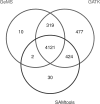SNP calling using genotype model selection on high-throughput sequencing data
- PMID: 22253293
- PMCID: PMC3338331
- DOI: 10.1093/bioinformatics/bts001
SNP calling using genotype model selection on high-throughput sequencing data
Abstract
Motivation: A review of the available single nucleotide polymorphism (SNP) calling procedures for Illumina high-throughput sequencing (HTS) platform data reveals that most rely mainly on base-calling and mapping qualities as sources of error when calling SNPs. Thus, errors not involved in base-calling or alignment, such as those in genomic sample preparation, are not accounted for.
Results: A novel method of consensus and SNP calling, Genotype Model Selection (GeMS), is given which accounts for the errors that occur during the preparation of the genomic sample. Simulations and real data analyses indicate that GeMS has the best performance balance of sensitivity and positive predictive value among the tested SNP callers.
Availability: The GeMS package can be downloaded from https://sites.google.com/a/bioinformatics.ucr.edu/xinping-cui/home/software or http://computationalbioenergy.org/software.html.
Supplementary information: Supplementary data are available at Bioinformatics online.
Figures
Similar articles
-
MultiGeMS: detection of SNVs from multiple samples using model selection on high-throughput sequencing data.Bioinformatics. 2016 May 15;32(10):1486-92. doi: 10.1093/bioinformatics/btv753. Epub 2016 Jan 18. Bioinformatics. 2016. PMID: 26787661 Free PMC article.
-
TotalReCaller: improved accuracy and performance via integrated alignment and base-calling.Bioinformatics. 2011 Sep 1;27(17):2330-7. doi: 10.1093/bioinformatics/btr393. Epub 2011 Jun 30. Bioinformatics. 2011. PMID: 21724593
-
Generation of SNP datasets for orangutan population genomics using improved reduced-representation sequencing and direct comparisons of SNP calling algorithms.BMC Genomics. 2014 Jan 10;15:16. doi: 10.1186/1471-2164-15-16. BMC Genomics. 2014. PMID: 24405840 Free PMC article.
-
Review of alignment and SNP calling algorithms for next-generation sequencing data.J Appl Genet. 2016 Feb;57(1):71-9. doi: 10.1007/s13353-015-0292-7. Epub 2015 Jun 9. J Appl Genet. 2016. PMID: 26055432 Review.
-
Toward better understanding of artifacts in variant calling from high-coverage samples.Bioinformatics. 2014 Oct 15;30(20):2843-51. doi: 10.1093/bioinformatics/btu356. Epub 2014 Jun 27. Bioinformatics. 2014. PMID: 24974202 Free PMC article. Review.
Cited by
-
Coval: improving alignment quality and variant calling accuracy for next-generation sequencing data.PLoS One. 2013 Oct 8;8(10):e75402. doi: 10.1371/journal.pone.0075402. eCollection 2013. PLoS One. 2013. PMID: 24116042 Free PMC article.
-
From genes to health - challenges and opportunities.Front Pediatr. 2014 Mar 3;2:12. doi: 10.3389/fped.2014.00012. eCollection 2014. Front Pediatr. 2014. PMID: 24624370 Free PMC article. Review.
-
A primer for disease gene prioritization using next-generation sequencing data.Genomics Inform. 2013 Dec;11(4):191-9. doi: 10.5808/GI.2013.11.4.191. Epub 2013 Dec 31. Genomics Inform. 2013. PMID: 24465230 Free PMC article. Review.
-
SNPest: a probabilistic graphical model for estimating genotypes.BMC Res Notes. 2014 Oct 7;7:698. doi: 10.1186/1756-0500-7-698. BMC Res Notes. 2014. PMID: 25294605 Free PMC article.
-
SNP Discovery Using a Pangenome: Has the Single Reference Approach Become Obsolete?Biology (Basel). 2017 Mar 11;6(1):21. doi: 10.3390/biology6010021. Biology (Basel). 2017. PMID: 28287462 Free PMC article. Review.
References
-
- Chakravarti A. Single nucleotide polymorphisms:… to a future of genetic medicine. Nature. 2001;409:822–823. - PubMed
-
- Dixon W.J. Analysis of extreme values. Ann. Math. Stat. 1950;21:488–506.
Publication types
MeSH terms
Grants and funding
LinkOut - more resources
Full Text Sources
Other Literature Sources



